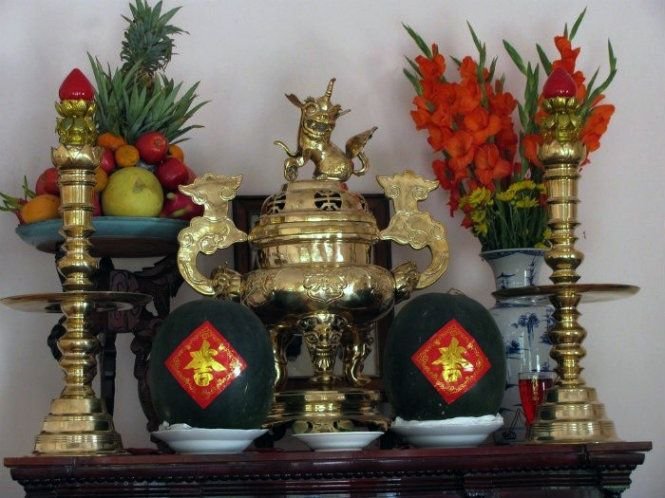THE VIETNAMESE SPIRITUAL LIFE HAS LONG BEEN RICH AND COMPLEX - JUST LIKE THE DEFINITIONS AND CONTROVERSIES SURROUNDING THE CONCEPT OF SPIRITUALITY. THIS ARTICLE WILL REFER TO SPIRITUAL FACTORS EXPRESSED THROUGH BELIEFS AND OUTSTANDING SPIRITUAL PHENOMENA IN THE SPIRITUAL LIFE OF VIETNAMESE PEOPLE FROM THE PAST TO THE PRESENT.
This article summarizes the research of the creative team at Red Cat when learning about the Vietnamese spiritual world, one of the biggest inspirations for the Karma Journey project.
The Vietnamese spiritual life has long been rich and complex - just like the definitions and controversies surrounding the concept of spirituality. This article will refer to spiritual factors expressed through beliefs and outstanding spiritual phenomena in the spiritual life of Vietnamese people from past to present.
FERTILITY RITES
The Vietnamese people have many beliefs, the first of which must be mentioned is the most ancient belief - fertility rites (phon thuc). "Phon" means many, "thuc" is flourishing. The fertility rites come from the agricultural culture of the ancient Vietnamese, with the desire to maintain and develop life through rice production and human production.
Symbols of fertility beliefs include two types: the first is to worship the male and female genital organs, and the second is to worship the act of mating itself. In the past, at the Dong Ki (Ha Bac) village festival, there was a custom to bring a “qi” (male sex organs) made of wood, then burn it and divide the ashes among the villagers. The ancients believed that this would bring good luck to the villagers and the crop and if ignored, the whole village would have bad luck in that year. Moreover, there was a custom of "mortar pounding to welcome the bride" of the ancients also had a basis from traditional beliefs. The pestle and mortar represent the genitals of a man and a woman, and the ancients believed that the pounding of the mortar to welcome the bride had the effect of wishing the couple to have "many children and grandchildren". The fertility rites have existed throughout history and are found on many relics and antiquities, including statues, bronze drums or caves. This forms the foundation for spiritual elements in Vietnamese spiritual life from the earliest days.
NATURE WORSHIP
Have you ever wondered why our nation is proud to be the son of Dragon and descendant of Fairy or the descendants of the Lac Hong? This belief took root from the worshiping of nature, including animals and plants, of the ancient Vietnamese. The image of Dragons and Fairies were originated from birds, snakes, crocodiles, animals that are abundant in rivers and were worshiped by the ancient Vietnamese. These animals were often engraved on the sides of bronze drums. The Dragon is a combination of crocodile and snake, born in the waters and flying to the sky, hence a Southeast Asian dragon does not have wings. The word “rong" (Vietnamese) and the word "long" (Sino-Vietnamese) were both derived from words in ancient Southeast Asian languages: krong, krông or klong, which means "river". Besides the Dragons, there is also Fairies. According to the legend, our ancestors belonged to the Hong Bang family, and Hong Bang was a large water bird.
Animation “Dragon and Fairy Legend” produced by Red Cat Motion and Sun Wolf Animation Studio.
It is the belief in nature worship that leads to worshiping all the "gods" that govern nature, which was the cause of Vietnamese polytheism. We worship Mother of Sky (Mau Cuu Trung, Cuu Thien Huyen Nu, Thien Mu), Mother of Earth (Dia Mau, Ba Chua Xu) and Mother of Water (Ba Thuy, Ba Chua Song). Later, when the consciousness with yin and yang appeared, we worshiped God (Ong Troi) and under the influence of Chinese culture, we had Jade Emperor (Ngoc Hoang), Tho Cong, and Ha Ba, but in the most ancient times, our ancestors mostly worshiped goddesses. Besides worshiping the Heaven, Earth, and Water, we also worship the gods who manage the weather (because weather affects the crops), the god of space and time (eg. Thap Nhi Hanh Kien - the twelve gods, each of whom manages a year according to the twelve guardian animals Mouse, Ox, Tiger, etc. and manages the birth, therefore we have Twelve Midwives).
Vietnamese people often say to each other: hu hon hu via, or ba hon bay via - these sayings were all derived from ancient spiritual beliefs, when people began learning about the world and surrounding phenomena. The Vietnamese people believe that there are three parts in each person: soul, body and spirit. Spirit is a concept to refer to the intermediate part between the body and the soul. According to the ancient concept, man’s spirit has seven parts and the woman’s has nine. This is also the ground for explaining phenomena like coma, fainting, death or pain in children. Because there is a spirit existing between the soul and body, there are also concepts such as “light spirit", "heavy spirit" and also give rise to spiritual practices such as "burning ill luck" in case of unfortunate events. When a person dies, the body and the spirit (which are considered “the heavy parts”) dissipate, but for the soul, since it is much lighter, it leaves the body and wanders on earth.
HUMAN WORSHIP
The Vietnamese also believe in an afterlife world existing alongside the human world. Therefore, for those who die, their souls after wandering in the living world will be led to the afterlife world, or eternity world. Thanks to this belief, we have the custom of worshiping our grandparents and ancestors. This custom is much more common in Vietnam than in other nations in Southeast Asia. It can be said that ancestor worship has almost become a religion in Vietnam (Taoism) and almost every Vietnamese family has an altar to worship grandparents. Our people believe that the living world and afterlife exist in the same way. Therefore, on the anniversary of the death, we offer food (with normal or vegan meals). In addition to food, we also offer clothes, utensils, and money (made of paper, collectively known as votive paper) so that the grandparents in the afterlife can have necessary items and amenities just like when they were living.
Altar of ancestor - Source: tuoitre.vn
OUTSTANDING SPIRITUAL PHENOMENA
From the basis of the oldest beliefs closely related to the spiritual world of the Vietnamese people, we find that there are some outstanding spiritual phenomena. These phenomena have a crucial role in the spiritual world and there was a period when strange related events were widely discussed in the community.
The first thing to mention is the phenomenon of calling souls (len dong) (to contact with the gods, enter the souls, talk to the dead). This phenomenon comes from the belief that people have souls and bodies and that the soul exists forever. There are souls which are so powerful that they can enter the living or another dead person (e.g. in the story of Truong Ba's Soul in the Butcher's Body). Calling souls is a phenomenon where the soul of a dead person is called to enter a living person (in this case, the body of a medium who performed the rituals). The called soul can be of the grandparents (descendants want to call the grandparents' soul to inquire something or ask for help) or it can be the soul of a certain god, or soul of a person who died unjustly so that the living person could ask why he or she died.
A dancing medium - Source: Wikipedia
Another well-known and widely discussed phenomenon is the extrasensory phenomenon (also known by many as finding martyrs' graves). A person with extrasensory power will have many different abilities such as: reading other people's minds, seeing events or objects in another place, foreseeing the future, or finding a living person or corpse of a dead person by touching an object (utility) related to the person to be found. If you're a fan of the Stranger Things series, then you can imagine a person with telepathic powers would be quite similar to Eleven. Unlike calling the souls, extrasensory phenomena are considered more positively, although both phenomena have in common that a living person can "call a soul" or communicate with the souls of the dead. The reason for this difference can be attributed to the merits of psychics who found the bodies of national heroes, such as Tran Phu and Nguyen Duc Canh. This is probably the crucial reason why psychics attract much attention and people with psychic abilities are more appreciated.
The above are just two of a series of other spiritual phenomena present in the spiritual life of Vietnamese people (for example, enchantments, ghosts, retribution, predestined ghosts, etc.). These facts prove that the spiritual world of the Vietnamese people is very rich and complex, from ancient times to the present.
THE DIVERSITY OF SPIRITUAL PHENOMENA, BELIEFS AND RELIGIONS IN VIETNAM IS PARTLY DUE TO THE INFLUENCE OF NEIGHBORING CULTURES, BUT IT CAN BE SAID THAT THE RELIGIOUS AND SPIRITUAL BELIEFS OF THE VIETNAMESE ORIGINATE FROM AGRARIAN CULTURE, THUS THERE ARE NATURE WORSHIPING BELIEFS, POLYTHEISTIC BELIEFS AND TAOISM, REFLECTING THE YIN AND YANG PHILOSOPHY (THE OBJECTS OF WORSHIP ALWAYS COME IN PAIR: HEAVEN - EARTH, DRAGON - FAIRY, MALE AND FEMALE MEDIUM, ETC.). IT IS ALSO BECAUSE OF THE RICHNESS AND COMPLEXITY IN THE SPIRITUAL LIFE THAT LEADS TO RELATED NEEDS, SUCH AS PRAYING WITH OUIJA BOARDS, PRAYING AT PAGODAS , FORTUNE TELLING, OR EVEN EXTREME SUPERSTITIOUS PHENOMENA SUCH AS CURING DISEASES OR ASKING FOR BENEFITS WITH ENCHANTMENTS, OR DRINK INCENSE OR DRINK ASHES TO CURE ILLNESS. THE GAP IN SPIRITUAL BELIEFS AND SUPERSTITION CAN BE VERY CLOSE, PLUS THE DIVERSITY AND COMPLEXITY IN SPIRITUALITY, WHICH IS THE REASON FOR US TO GAIN MORE KNOWLEDGE TO BE ABLE TO CHOOSE FOR OURSELVES THE RIGHT SPIRITUAL VALUES AND BRING SPIRITUAL BENEFITS TO EACH INDIVIDUAL AND COMMUNITY.
Yen Tam
References:
Tracing back to Vietnamese cultural identity - Professor-Academic Tran Ngoc Them
http://dsvh.gov.vn/Upload/files/Tap chi DSVH/So 26/2609_Van de tam linh va van hoa tam linh hien nay.pdf
https://vi.wikipedia.org/wiki/Tâm_linh
http://khxhnvnghean.gov.vn/m/?x=4062/nghien-cuu-khxhnv/ngay-xuan-lam-ban-ve-doi-song-tam-linh-hien-nay
Check out other articles here:
-
2022
- Jul 7, 2022 VIETNAMESE CULTURE: THE PIG IN OUR CULTURE
- Jul 7, 2022 SUN WOLF ANIMATION STUDIO OPENING EVENT
- Jul 7, 2022 VIETNAMESE CUISINE IN ANIMATION “LINH”
- Jun 13, 2022 ANIMATION JOURNAL: LINH WORLD’S ECO SYSTEM
- Jan 20, 2022 Animation journal: “Nghê" - The Vietnamese Guardian Animal
- Jan 18, 2022 Animation journal: hoi an
- Jan 14, 2022 Animation journal: vietnamese fish vermicelli soup
- Jan 1, 2022 Animation journal: vietnamese spiritual life
-
2021
- Oct 20, 2021 Animation journal: Colour Script
- May 30, 2021 Animation journal: Gạo’s house
- Mar 12, 2021 Animation journal: script & Storyboard


